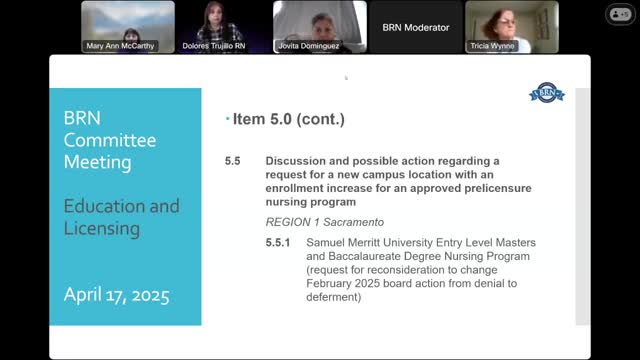Samuel Merritt University seeks deferment for Sacramento campus enrollment increase
April 23, 2025 | Respiratory Care Board of California, Boards and Commissions, Executive, California
Thanks to Scribe from Workplace AI and Family Portal , all articles about California are free for you to enjoy throughout 2025!

This article was created by AI using a video recording of the meeting. It summarizes the key points discussed, but for full details and context, please refer to the video of the full meeting. Link to Full Meeting
The first request came from Samuel Merritt University, seeking to overturn a previous board decision that denied an enrollment increase for its Sacramento campus. Instead of outright approval, the committee considered a motion to defer the decision, allowing the university time to submit additional information and explore alternative clinical sites in the Northern San Joaquin Valley. This approach aims to provide the university with a fair opportunity to address concerns raised during the last meeting, where the denial was deemed an unusual course of action.
Committee members expressed a cautious optimism about the deferment, emphasizing the importance of maintaining oversight to ensure that clinical placements align with the university's commitments. The board's ability to track clinical placements through a new databank, set to launch on May 1, was highlighted as a crucial tool for accountability. This system will enable the board to verify that nursing programs are adhering to their proposed plans, thereby safeguarding the integrity of nursing education in the region.
However, the meeting also revealed deep-seated concerns among educators regarding the saturation of nursing programs in Sacramento. Public comments from various stakeholders, including faculty from local universities, voiced apprehensions about the potential impact of new programs on existing nursing education and clinical placements. Many argued that the region is already facing challenges in securing adequate clinical sites and faculty, and adding more programs could exacerbate these issues.
The second major topic of discussion involved a feasibility study submitted by Arizona College for a new baccalaureate nursing program in Rancho Cordova, just a stone's throw from existing institutions. Public comments overwhelmingly opposed this proposal, citing concerns about competition for limited clinical resources and the potential negative impact on current nursing programs. Educators emphasized that the region is already struggling to meet the demands of nursing education, and introducing additional programs could jeopardize the quality of training for future nurses.
As the meeting concluded, the committee faced a critical decision that could influence the landscape of nursing education in California. The discussions underscored the delicate balance between expanding educational opportunities and ensuring that existing programs can thrive without being overwhelmed. With the board's commitment to accountability and oversight, the future of nursing education in the Sacramento area remains a topic of keen interest and concern among educators and stakeholders alike.
Converted from Board of Registered Nursing - Education Licensing Committee Meeting - April 17, 2025 meeting on April 23, 2025
Link to Full Meeting
Comments
View full meeting
This article is based on a recent meeting—watch the full video and explore the complete transcript for deeper insights into the discussion.
View full meeting